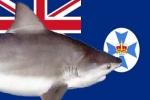Basking sharks exhibit different diving behavior depending on the season
Press Release University of Exeter 26. September 2019 — — — —- —- — Tracking the world’s second-largest shark species has revealed that it moves to different depths depending on the time of year. Basking sharks spend most of the summer months at the ocean’s surface, but dive to deeper depths in winter. This seasonal
Seasonal changes in basking shark vertical space use in the north-east Atlantic
Seasonal changes in basking shark vertical space use in the north-east Atlantic P. D. Doherty, J. M. Baxter, B. J. Godley, R. T. Graham, G. Hall, J. Hall, L. A. Hawkes, S. M. Henderson, L. Johnson, C. Speedie, M. J. Witt ABSTRACT: Mobile marine species can exhibit vast movements both horizontally and vertically. Spatial analysis
AUS: Federal laws prevent extra shark control gear being deployed in Cairns
Media Statement Minister for Agricultural Industry Development and FisheriesThe Honourable Mark Furner 25. September 2019 — — — — — — — — The Palaszczuk Government is moving quickly to install additional shark control equipment at a number of Queensland coastal locations, but Federal legislation is preventing extra equipment being deployed in Cairns. Minister for
DNA analysis of elasmobranch products originating from Bangladesh reveals unregulated elasmobranch fishery
DNA analysis of elasmobranch products originating from Bangladesh reveals unregulated elasmobranch fishery and trade on species of global conservation concern Alifa Bintha Haque, Sudipta Arka Das, Aparna Riti Biswas ABSTRACT: Trade involving elasmobranch products in Bangladesh is a four-decade-long practice in large scale and there is little understanding of its impact on species composition, population,
Climate cooling and clade competition likely drove the decline of lamniform sharks
Climate cooling and clade competition likely drove the decline of lamniform sharks Fabien L. Condamine, Jules Romieu, Guillaume Guinot ABSTRACT: Understanding heterogeneity in species richness between closely related clades is a key research question in ecology and evolutionary biology. Multiple hypotheses have been proposed to interpret such diversity contrasts across the tree of life, with
The neglected complexities of shark fisheries
The neglected complexities of shark fisheries, and priorities for holistic risk-based management Hollie Booth, Dale Squires, E.J. Milner-Gulland ABSTRACT: Sharks and their cartilaginous relatives (Class Chondrichthyes, herein ‘sharks’) are one of the world’s most threatened species groups. Their slow life history traits and vulnerability to capture make them particularly susceptible to overfishing, and they are
Threatened shark species in pet food and beauty care products
Genetic identification of threatened shark species in pet food and beauty care products Diego Cardeñosa ABSTRACT: Contemporary global demand for shark commodities such as fins, meat, and liver oil, is arguably the main driver of shark overexploitation trends observed in the last three decades. Shark are most commonly traded for their fins to be used in
Great Barrier Reef: Shark Nets Removed After Court Ruling
Media Statement Minister for Agricultural Industry Development and FisheriesThe Honourable Mark Furner 19. September 2019 — — — — — — — — — Shark nets removed from Great Barrier Reef Marine Park Shark nets are being removed from the Great Barrier Reef Marine Park after a Federal Court decision backed major changes to the
Shark pups lose gains in stressed environments
Media Release ARC Centre of Excellence for Coral Reef Studies 17. September 2019 — — — — — — — — — — A prominent JCU shark researcher is part of an international team that found shark babies can’t reach their physical peak if they’re born into environments degraded by human-induced stressors, including climate change.
Investigating body condition and foraging success in young reef sharks between an atoll and an island system
Same species, different prerequisites: investigating body condition and foraging success in young reef sharks between an atoll and an island system Ornella C. Weideli, Ian A. Bouyoucos, Yannis P. Papastamatiou, Gauthier Mescam, Jodie L. Rummer, Serge Planes ABSTRACT: Acquiring and storing energy is vital to sharks of all age-classes. Viviparous shark embryos receive endogenous maternal
An environmental DNA tool for monitoring the status of Smalltooth Sawfish
An environmental DNA tool for monitoring the status of the Critically Endangered Smalltooth Sawfish, Pristis pectinata, in the Western Atlantic Ryan N. Lehman, Gregg R. Poulakis, Rachel M. Scharer, Katherine E. Schweiss, Jill M. Hendon, Nicole M. Phillips ABSTRACT: The Critically Endangered Smalltooth Sawfish, Pristis pectinata, was once widespread in the tropical and subtropical waters
High-performance suction feeding in an early elasmobranch
High-performance suction feeding in an early elasmobranch Michael I. Coates, Kristen Tietjen, Aaron M. Olsen, John A. Finarelli ABSTRACT: High-performance suction feeding is often presented as a classic innovation of ray-finned fishes, likely contributing to their remarkable evolutionary success, whereas sharks, with seemingly less sophisticated jaws, are generally portrayed as morphologically conservative throughout their history.
Multiple recurrent cutaneous masses in a cownose ray with progression from benign lesions to high‐grade carcinoma
Multiple recurrent cutaneous masses in a cownose ray (Rhinoptera bonasus) with progression from benign lesions to high‐grade carcinoma Bryan S. Vorbach, Lauren B. Peiffer, Leigh A. Clayton, Lisa M. Mangus ABSTRACT: Abstract not available Journal of Fish Diseases, Early View, DOI: 10.1111/jfd.13081 SOURCE
Multi-method assessment of whale shark residency, distribution, and dispersal behavior
Multi-method assessment of whale shark (Rhincodon typus) residency, distribution, and dispersal behavior at an aggregation site in the Red Sea Jesse E. M. Cochran, Camrin D. Braun, E. Fernando Cagua, Michael F. Campbell Jr., Royale S. Hardenstine, Alexander Kattan, Mark A. Priest, Tane H. Sinclair-Taylor, Gregory B. Skomal, Sahar Sultan, Lu Sun, Simon R. Thorrold,
In situ observations of deep-living skates
In situ observations of deep-living skates in the eastern North Pacific L.A. Kuhnz, J.J. Bizzarro, D.A .Ebert ABSTRACT: We report on 18 years of in situ observations of seven skate species (2192 individual observations) in the eastern North Pacific (Vancouver Island, Canada to the Gulf of California, Mexico) between 200 and 3322 m depth. Biological (species,






